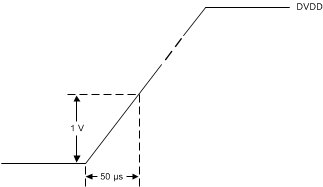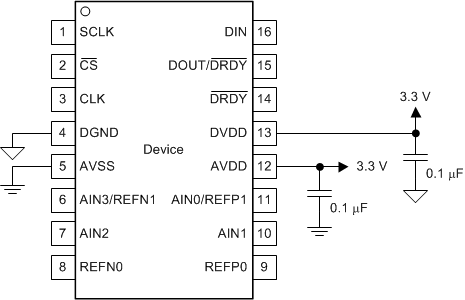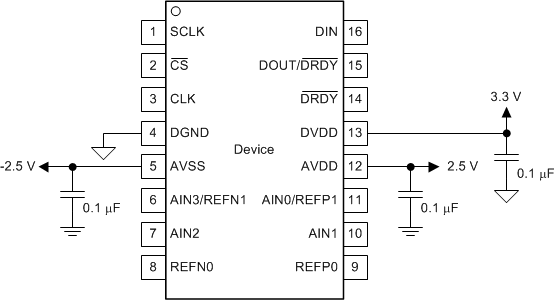SBAS535C August 2013 – February 2017 ADS1120
PRODUCTION DATA.
- 1 Features
- 2 Applications
- 3 Description
- 4 Revision History
- 5 Pin Configuration and Functions
- 6 Specifications
- 7 Parameter Measurement Information
-
8 Detailed Description
- 8.1 Overview
- 8.2 Functional Block Diagram
- 8.3 Feature Description
- 8.4 Device Functional Modes
- 8.5 Programming
- 8.6 Register Map
- 9 Application and Implementation
- 10Power Supply Recommendations
- 11Layout
- 12Device and Documentation Support
- 13Mechanical, Packaging, and Orderable Information
Package Options
Mechanical Data (Package|Pins)
Thermal pad, mechanical data (Package|Pins)
- RVA|16
Orderable Information
10 Power Supply Recommendations
The device requires two power supplies: analog (AVDD, AVSS) and digital (DVDD, DGND). The analog power supply can be bipolar (for example, AVDD = 2.5 V, AVSS = –2.5 V) or unipolar (for example, AVDD = 3.3 V, AVSS = 0 V) and is independent of the digital power supply. The digital supply sets the digital I/O levels.
10.1 Power-Supply Sequencing
The power supplies can be sequenced in any order, but in no case must any analog or digital inputs exceed the respective analog or digital power-supply voltage and current limits. Ramping DVDD together with or before AVDD minimizes any leakage current through AIN3/REFN1 because of the low-side switch connected to this input. If AVDD ramps before DVDD, then the low-side switch is in an unknown state and can short the AIN3/REFN1 input to AVSS until DVDD has ramped. Wait approximately 50 µs after all power supplies are stabilized before communicating with the device to allow the power-up reset process to complete.
10.2 Power-Supply Ramp Rate
For proper device power-up over the entire temperature range, the power-supply ramp rate must be monotonic and slower than 1 V per 50 µs, as shown in Figure 83.
 Figure 83. Power-Supply Ramp Rate
Figure 83. Power-Supply Ramp Rate
10.3 Power-Supply Decoupling
Good power-supply decoupling is important to achieve optimum performance. AVDD, AVSS (when using a bipolar supply) and DVDD must be decoupled with at least a 0.1-µF capacitor, as shown in Figure 84 and Figure 85. Place the bypass capacitors as close to the power-supply pins of the device as possible using low-impedance connections. TI recommends using multi-layer ceramic chip capacitors (MLCCs) that offer low equivalent series resistance (ESR) and inductance (ESL) characteristics for power-supply decoupling purposes. For very sensitive systems, or for systems in harsh noise environments, avoiding the use of vias for connecting the capacitors to the device pins may offer superior noise immunity. The use of multiple vias in parallel lowers the overall inductance and is beneficial for connections to ground planes. TI recommends connecting analog and digital ground together as close to the device as possible.
 Figure 84. Unipolar Analog Power Supply
Figure 84. Unipolar Analog Power Supply
 Figure 85. Bipolar Analog Power Supply
Figure 85. Bipolar Analog Power Supply